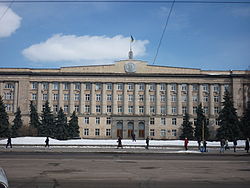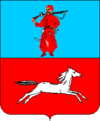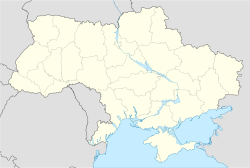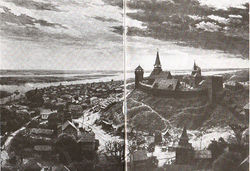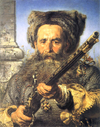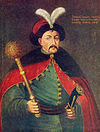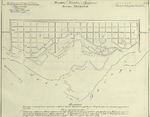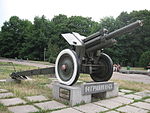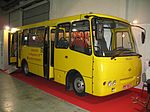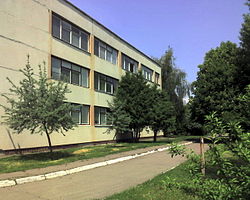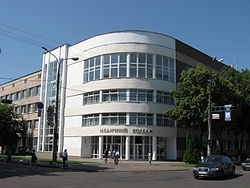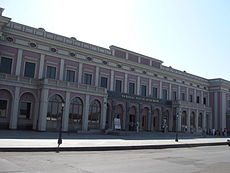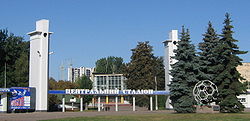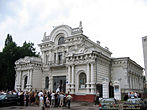- Cherkasy
-
Cherkasy (Черкаси)
Cherkassy (Черкасcы)Central square of the city, Soborna (Cathedral) Square 
Flag
Coat of armsMap of Ukraine with Cherkasy highlighted. Location of Cherkasy Coordinates: 49°26′40″N 32°03′35″E / 49.44444°N 32.05972°ECoordinates: 49°26′40″N 32°03′35″E / 49.44444°N 32.05972°E Country  Ukraine
UkraineOblast  Cherkasy Oblast
Cherkasy OblastRaion Cherkasy Raion First mentioned 1286 City status 1795 Government - Mayor Serhiy Olehovych Odarych[1] Area - Land 69 km2 (26.6 sq mi) Elevation 110 m (361 ft) Population (02-01-2011) - Total  287 583
287 583- Density 4,170/km2 (10,800.3/sq mi) Time zone EET (UTC+2) - Summer (DST) EEST (UTC+3) Postal code 18000 — 18499 Area code(s) +380 472 Licence plate АН Sister cities Bydgoszcz, Sumgait, Santa Rosa Website www.rada.cherkassy.ua Cherkasy (Ukrainian: Черкаси, transliterated: Čerkasy, pronounced [tʃerˈkɑsɪ]) or Cherkassy (Russian: Черкасcы), is a city in central Ukraine. It is the capital of the Cherkasy Oblast (province), as well as the administrative center of the surrounding Cherkasky Raion (district) within the oblast. The city itself is also designated as its own separate raion within the oblast.
The city is the cultural, educational and industrial center of Cherkasy Oblast and Central Economical Region of Ukraine. Cherkasy is known since the 13th century and played a great role in the history of Ukraine. Cherkasy was the center of Cossacks, citizens took part in Khmelnychchyna and Koliyivschyna (cossacks and peasants rebellions).
The city is located on the right bank of Dnieper River (specifically at the Kremenchuk Reservoir), about 200 km (124 mi) south of the nation's capital, Kiev. The city is divided into 2 boroughs (raions) - Sosnivskiy (with Orshanets village) and Pridniprovskiy. The current population of Cherkasy is 287,583 (as of 2011). In June 2011, the city celebrated its 725 anniversary.
Contents
Environment
Location
Cherkasy is situated on the high right bank of the Dnipro River, in the middle of the Kremenchuk Reservoir. Relief of the historical part of the city was influenced by Zamkova (Castle) mountain, where Cherkasy Fortress was situated. The major part of Cherkasy occurs as lowlands.
The city occupies an area of 69 km (42.87 mi). The city's length is 17 km (10.56 mi) along the Kremenchuk Reservoir, while its width is only 8 km (4.97 mi).
From the North-West Cherkasy is surrounded by forest. Known as Cherkaskiy Bir (Cherkasy Forest), it is the biggest (28,500 hectares) natural pine forest in Ukraine.[2]
Climate
The climate of Cherkasy is mild continental with mild winters and warm (sometimes hot) summers.[3]
The average temperature in the city is +7,7 °C. Winters are usually cold and snowy (the average January temperature is -5,9 °C), but the last few winters have been rather warm with rare severe frosts (up to -25 °C). Summers are dry and warm (the average temperature in July is +19,8 °C), with occasional highs reaching +35 °C.
Climate data for Cherkasy Month Jan Feb Mar Apr May Jun Jul Aug Sep Oct Nov Dec Year Average high °C (°F) −3
(27)−1
(30)3
(37)12
(54)20
(68)23
(73)25
(77)24
(75)19
(66)12
(54)5
(41)0
(32)11 Average low °C (°F) −8
(18)−6
(21)−2
(28)5
(41)10
(50)13
(55)15
(59)14
(57)10
(50)4
(39)0
(32)−5
(23)4 Rainfall mm (inches) 36
(1.42)33
(1.3)29
(1.14)38
(1.5)37
(1.46)63
(2.48)76
(2.99)53
(2.09)36
(1.42)31
(1.22)41
(1.61)44
(1.73)517
(20.35)Source: MeteoProg Ecology
The ecological situation in the city is quite stable. The cumulative pollution index as of 2008 is 7.56, average with other Ukrainian cities. The main pollutant in the city is "Azot" plant, so the nearby area (South-East part of the city) is the most polluted.[4] The downtown area is heavily polluted as well, due to high traffic volume. The city itself is mostly clean of nuclear pollution from the Chernobyl disaster, although the northernmost part of Cherkasy may have been influenced a little.[5]
Demographics
According to the newest data, the number of inhabitants of Cherkasy is 287,583 as of February 1, 2011. This number is decreasing because of rising mortality rate, socio-economic situation, and the suburbanisation process in the region.
This diagram shows the changes of population in Cherkasy:

The majority of citizens are Ukrainians, with a large population of Russians and Jews. 46,4% are males, 53,6% are females.[6] According to the data provided by the municipal health care department, teens under 14 encompass 15% of the population while pensioners are 19%, which indicates the prevalence of aging citizens as compared to younger citizens.
History
Early history
The history of Cherkasy has not been thoroughly explored. This can be explained by the fact that the city was forming under the Russian (and later Soviet) rule, which is why some periods in the life of Cherkasy still remain undiscovered (a lot of facts were hidden, documents and material proof was destroyed). The year of establishment is considered to be 1286. There are few facts about the beginning of the city's life, but it is documented that Cherkasy existed in the 14th century. The first record about Cherkasy was made in 1305 and was found in the Gustynskiy Chronicle, which is the Ukrainian chronicle. The city is mentioned as an existing city among other Ukrainian cities, including Kiev, Kaniv, Zhytomyr and Ovruch.
The city was one of the centers of the Cossack movement. Citizens took part in Khmelnychchyna and Koliyivschyna. The city was influenced by the cruel social and economical experiments of Soviet authorities and World War II. In 1954, Cherkasy became the administrative center of Cherkasy Oblast (province), the youngest oblast of Ukraine.
Under Grand Duchy of Lithuania
Starting from 1360s, the city enters a new period in its development - it becomes a part of Grand Duchy of Lithuania. Since that, Cherkasy becomes important defender of Southern borders. In 1384 the city is mentioned as fortified town on the South edge (of Grand Duchy of Lithuania), along with Vinnytsia, Bratslav and Kaniv making defensive line from Crimean Tatars. The city started to be ruled by headman (starosta).
During the end of 15th - beginning of 16th centuries the post of Cherkasy headman was held by the prominent persons of that time - Bogdan Glinskiy, Kmyta Oleksandrovych, Vasyl Dashkevych, Andriy Nemyrovych, Ostafiy Dashkevych, Vasyl Tyshkevych, Dmytro Baida-Vyshnevetskiy etc.
During 15th-16th centuries, Cherkasy was one of the main centers that helped Cossacks in population of Ukrainian South. Citizens took part in military marches against Tatars and Turkish, including operations led by Ivan Pidkova. New Cherkasy Castle was the center of city life, it was built in 1549-52 on the place of the old one.
Under Polish rule, Khmelnytsky Uprising
After Union of Lublin in 1569 Cherkasy became a part of Poland. Cherkasy Regiment, which was created in 1625, played a big role in history of the city. During War for Independence regiment became administrative-territorial subdivision (until 1686). During that time Cherkasy Regiment was one of the most powerful military units and took part in all battles for Bohdan Khmelnytsky army.
Elimination of Polish rule helped with city's development. But after several unsuccessful Cossack attacks against Poland, Bogdan Khmelnytsky had to sign union with Russian Empire. Signing supposed to be held in Cherkasy, but Polish invasion interfered. Diplomats moved to Pereyaslav, where Pereyaslivska Rada was held. After Pereyaslivska Rada, Cherkasy became a part of Poland for long time. In 1791 the city gained Magdeburg rights.
XIX - beginning of XX centuries
Since the beginning of XIX century the city was planned by Russian architect, civil engineer and town planner of Scottish descent, William Heste. After second division of Poland in 1793, Cherkasy became a part of Russian Empire. Since 1797 it was a povitove town of Kiev Governorate. In the second half of XIX century the city experienced a great economical growth. After the railroad appeared in the city, a lot of new industrial enterprises were built. Sugar, tobacco, metalwork, mechanical engineering and trade industries were at peak development at that time. Architect William Heste made a general development plan for the city, which involved building square blocks with straight streets.
XX Century (Soviet time)
After October revolution in 1917 Cherkasy got under the rule of bolshevikis. After that, however, the city changed its rule for at least 10 times - during the civil war it was conquered by hetman Pavlo Skoropadskyi, then again by bolshevikis, later by Nikifor Grigoriev. On January 1, 1920, the city finally and for long time got under Soviet rule. As all villages and towns in the area, it was a victim of man-made famine in 1932-1933 (Holodomor) and a Great Purge (a series of campaigns of political repression and persecution in the Soviet Union organised by Joseph Stalin in 1936–1938).
The Second World War damaged the city greatly. On June 22, 1941, German bombers attacked Cherkasy. For two months soldiers were defending the city, but on August 22, invaders took the city. On December 14, 1943, Cherkasy was set free from German invaders. After the end of the war, the city began to recover after being almost destroyed. According to 5-year plans, the city began to re-develop its economy, infrastructure and socio-cultural sphere. In 1954 the city became the administrative center of Cherkasy Oblast (province), the youngest among other oblasts in Ukraine. In 1960s Cherkasy became the chemical giant of Ukrainian SSR, after "Azot" (the biggest nitrogen fertilizer producing plant), "Himvolokno" (artificial fiber manufacturing plant), "Himreaktyv" (chemical reagents for military purposes) and many others were built in the city. In 1961 a Kremenchuk hydro power plant was built, forming Kremenchuk Water Reservoir, on which Cherkasy is standing now. This made the city a big transport hub, serving the longest dyke in Ukraine (15 km) with rail and road on it.
Independence
After gaining the independence, the industry in the city is declining, along with number of citizens and level of life. A lot of big and powerful factories and plants were privatized but couldn't stay alive on competitive market. Some enterprises changed their profile - several (3) factories and plants around the city were united under the "Bogdan Corporation" and started the production of buses and cars. Some of the companies remained working and became successful, like "Azot". On November 28, 2008, the monument of Lenin was removed from the central square. This caused different reactions in different people. Now the central square, formerly called "Lenin Square", is called "Soborna Square" (Cathedral Square). The square was recently renovated. In 2009, Cherkasy airport got the status of International Airport (IATA: CKC – ICAO: UKKE).
Transportation
Local transportation
Public transport is represented by trolleybuses and buses. Trolleybuses started serving the city in 1965, and now are operating on 10 routes, from approximately 6am till 11pm. The fleet is old, and mostly consists of ZiU-9 and ZiU-10 vehicles. Recently, 3 new trolleybuses (manufactured by LAZ) appeared in the city. Buses are mostly represented with "Etalon", "Bohdan", and "PAZ" buses. Cherkasy City Bus is the authority that controls the buses in the city, it consists of several private contractors which actually operate the transport system.
Roads
Cherkasy is a big transport hub due to its location in the center of the country. Two major automobile routes are going through the city - H16 (Uman-Zolotonosha, national route) and P10 (Kaniv-Kremenchuk, regional route). There is a 4-lane highway between Cherkasy and Smila (city which is a part of Cherkasy Urban Agglomeration). The roads are in poor technical condition and road maintenance is poor.
Railways
The city has a railway station and one railway stop, both are operated by state-owned Ukrzaliznytsia company. Cherkasy has regular connections to neighboring cities with small diesel trains. Major route Odessa-Moscow is passing through Cherkasy. One of the most important railway junctions in Ukraine, is located 23 kilometers from Cherkasy, in the city of Smila, where the Kiev–Dnipropetrovsk and Odessa–Moscow rail routes cross.
Air and Water transport
As Cherkasy is located on the bank of Kremenchuk reservoir, it has a small riverport. The previously extensive riverboat service along the Dnieper featuring the Raketa hydrofoil ships is no longer existing, limiting river transport to cargo and tour boats and private pleasure craft. There is also a cargo port located in the city.
Cherkasy International Airport is located on the western edge of the city. It works for chartered flights around Ukraine, the reason lies behind Boryspil airport in Kiev (which handles most of Ukraine's International flights). In addition, Cherkasy airport is considered as alternative airport for Boryspil in case of unforeseen situations and adverse weather conditions.
Education
Nowadays there are different types of educational institutions in Cherkasy - pre-school (kindergartens), schools, out-of-school and higher educational institutions. These institutions may be both state-owned and private property.
Pre-school education is represented with 50 kindergartens around the city.
City-owned schools are 21 general schools, 1 night school, and 14 new-type schools - 2 lyceums, 3 gymnasiums, collegiate, 8 specialized schools. This include First City Gymnasium, City Gymnasium #9 and #31, Cherkasy Physical and Mathematical Lyceum, Cherkasy Lyceum of Humanities and Law, Specialized School #17 (Associated UNESCO school), Cherkasy Collegiate "Beregynia", Specialized Schools #3, #13, #18, #20, #27, #28 and #33. Private schools are "Perlyna", school #770, and "Sofia".
Out-of-school institutions are Center of Youth Art, Young Sailors Club, Center of Tourism and Sports.
There is a number of post-secondary educational institutions:
- National Bohdan Khmelnytsky University of Cherkasy
- Cherkasy State Technological University
- Cherkasy Institute of Bank Affairs (branch of Ukrainian Academy of Bank Affairs of National Bank of Ukraine)
- Academy of fire safety of Heroes of Chornobyl
- East European University of Economics and Management (private)
- Odessa National Law Academy (branch)
There is a number of colleges (both state and private):
- Cherkasy Medical College
- Cherkasy State Business College
- Cherkasy Commercial Technical School
- Cherkasy Musical College
- Cherkasy Cooperative Economics and Law College
Several public libraries are serving the city - Central Library of Lesia Ukrainka, City Library for Youth and Children, Central Oblast Library of Taras Shevchenko.
Culture and recreation
Cherkasy is a big cultural center. Several theaters, philharmonic, 3 movie theaters, numerous museums and clubs are serving the city. The city has 3 indoor skating rinks. People can relax in big parks and gardens around the city, they can also visit city's zoo. Cherkasy is among the cities in Ukraine that have their own planetarium.
Museums
The biggest museums of Cherkasy are:
- Cherkasy Oblast Local History Museum - the collection of artifacts from the history, nature, culture, and ethnography of Cherkasy Oblast.
- "Kobzar" Museum of Taras Shevchenko - the only museum in the world about one book.
- Cherkasy Art Museum - big museum where different exhibitions are held throughout the year.
- Cherkasy Literary Memorial Museum of Vasyl Symonenko.
- Cherkasy Museum of Vyshyvanka
Theaters and Music
There are several theaters in Cherkasy, such as:
- Taras Shevchenko Ukrainian Academic Drama Theatre of Cherkasy
- Cherkasy Academic Puppet Theater
- Youth Theater "Suchasnyk"
The city has its own philharmonic, which was created in 1955. The big cultural center is concert hall "Druzhba Narodiv" (Friendship of Nations), where all major concerts are held. Besides, there are numerous local cultural clubs.
The city has 3 modern movie theaters - "Salut" (a very old building, was the first cinema in Cherkasy), "Ukraine", and "Dnipro Plaza".[7]
Recreation
Cherkasy is famous as a green city. The main parks are Park Peremohy (Victory Park) with a zoo, Sobornyi Park (Cathedral Park), Juvileyniy Park (Jubilee Park), Park Himikiv (Park of Chemists), Dolyna Troiand (Rose Valley), and 2 chilred's parks.[8] Traditional places of summer recreation are beaches of Dnipro River. The coastline of the city is as long as 15 km, and is usually represented with sand beaches. Infrastructure of the beaches is under development right now, although several recreational complexes are already built. On the northern end of the city, in Cherkasy Forest, sanatorium "Ukraine" is situated, along with three-star hotel "Ukraine", and "Kosmos-Bowling" club. There are also several hotels in the city which can accommodate people with different tastes.
Festivals
The city is famous for its sculpture festivals - "Kryzhtal" (held in winter, sculptures are made of ice), "Drevlyandia" (held in summer, sculptures are made of wood, then placed in parks around the city), and "Zhyvyi Kamin" (held in fall, sculptures are made of stone). Along with the last, "Cherkasy's Singing Nights" are held in the open-air theater in park. Since 2003, Cherkasy hosts international bike festival "Tarasova Gora", which gathers bikers from Ukraine, Russia, and other European countries. This is the biggest festival of this kind held in Ukraine.
Mass media
Cherkasy is a big media market, which is served by several local TV stations, newspapers, and numerous radio stations.
The city is a home to numerous newspapers, among which are "Antenna", "Molod' Cherkashchyny", "Vechirni Cherkasy", "Akcent", "Nova Doba", "Misto", "Cherkasky Kray" etc.
Cherkasy has 5 TV stations - Vikka, Antenna-Plus, Media-Center, Expo-TV, and state-owned Ros'. The city is also covered with nationwide channel broadcasting,[9] like 1+1, Inter, ICTV, STB, TET etc. .
City's radio stations are mostly nationwide networks broadcasted on local frequencies, although some local stations exist. FM radio stations include KISS FM, Hit FM, Radio Luks, Radio Rocks, Shanson, Ros', Era FM, Love Radio, 101Dalmatin, Dobre Radio.
Sports
Sport life of the city is concentrated in several places, among which are the Central Stadium, Water Sport station, Sport Center "Spartak", "Ukraine"; Sport arena "Budivel'nyk"; "Astra", "Central", "Sokil" swimming pools; 2 ice rinks. Also, there are sport-entertainment centers, such as "Selena", "Bochka", and "Sportohota" which can usually be found on the bank of the Dnipro River.
Every year more than 200 sport events, contests, competitions, tournaments are held in the city, with total of 10,000 participants. Some contests that were held recently include:
- Ukrainian Aquabike Cup in 2008 hosted bikers from Cherkasy, Odessa, Kiyv, and Dnipropetrovsk. It was held in "Bochka" entertainment center.
- Kremenchuk Reservoir Cup - yacht contest among cities located on Kremenchuk Reservoir. Hosted 27 teams from Svitlovodsk, Kremenchuk, Cherkasy, and Komsomolsk.
- Ukrainian Beach Volleyball Championship - was held in 2008 on the courts of "Rybka" complex
- Group 2 Euro/Africa Zone matches of 2008 Davis Cup were held in Cherkasy, in "Selena" sport complex.
Other sport achievements are:
- Cherkasy is home to the basketball club BC Cherkasy (a.k.a. the Cherkasy Monkeys).
- Cherkasy is home to the volleyball clubs Krug Cherkasy, Zlatogor Zolotonosha Cherkasy (women) and Impexagro Sport Cherkasy (men). They all play in the European tournaments 2008/2009.
- Cherkasy is represented within Ukrainian Bandy and Rink-bandy Federation.[10]
Architecture
International relations
See also: List of twin towns and sister cities in UkraineThis is a list of cities that have standing links to local communities in other countries. In most cases, the association, especially when formalised by local government, is known as "town twinning" (though other terms, such as "partner towns" or "sister cities" are sometimes used instead), and while most of the places included are towns, the list also comprises villages, cities, districts, counties, etc. with similar links. For example, the State of Iowa have been a sister state with Cherkasy Oblast since 1996.
 Bydgoszcz, Poland
Bydgoszcz, Poland Santa Rosa, United States
Santa Rosa, United States Sumgait, Azerbaijan
Sumgait, Azerbaijan
Gallery
-
Statue of Lenin on the central square. The statue was removed on November 28, 2008, and the square was renamed to Cathedral Square.
-
Building, where civil registry agency is located.
-
Taras Shevchenko statue near Drama Theater.
-
Entrance to the Cherkasy Central Stadium.
References
- ^ (Ukrainian) Сергій Одарич формуватиме більшість у міськраді Черкас, Cherkasy city counsil website (November 8, 2010)
- ^ (Ukrainian) http://mestectvo.com/cherkassy/zolotaya-podkova/cherkassy.html
- ^ Клімат Черкас (підготовлено Вишневським В. І.) на www.meteoprog.ua (Погода в Україні й світі. Прогноз погоди.)
- ^ (Ukrainian) The city council report on ecological situation in the city http://www.rada.cherkassy.ua/ua/newsread.php?view=17&s=1&s1=69
- ^ (Ukrainian) The map of nuclear pollution in Ukraine http://chornobyl.in.ua/uk/karty-radiacia-ukraina.html
- ^ Сайт Державного комітету статистики України. Дані перепису 2001 року
- ^ http://kino.ukr.net/cinema/cherkassy/
- ^ http://www.landarchitecture.org.ua/doku.php/parks/abc
- ^ http://en.wikipedia.org/wiki/Television_in_Ukraine
- ^ http://www.ukrbandy.org.ua/contact_en.html
- ^ http://rada.ck.ua/index.php?page=spivpracia
- (Ukrainian) (1972) Icтopiя мicт i ciл Укpaїнcькoї РCP - Черкаськa область (History of Towns and Villages of the Ukrainian SSR - Cherkasy Oblast), Kiev.
External links
- (English)/(Ukrainian)/(Russian) Official city portal
- (English) Cherkasy guide
- (English)/(Ukrainian)/(Russian) Unofficial info portal
- (English)/(Ukrainian)/(Russian) http://www.gorod.ck.ua/
- (English)/(Ukrainian)/(Russian) Phone book of Cherkasy
Administrative divisions of Cherkasy Oblast, Ukraine Administrative center: Cherkasy Raions Cherkasy · Chornobay · Chyhyryn · Drabiv · Horodyshche · Kamyanka · Kaniv · Katerynopil · Khrystynivka · Korsun-Shevchenkivskyi · Lysianka · Mankivka · Monastyryshche · Shpola · Smila · Talne · Uman · Zhashkiv · Zolotonosha · Zvenyhorodka

Cities Cherkasy · Chyhyryn · Horodysche · Kamianka · Kaniv · Khrystynivka · Korsun-Shevchenkivskyi · Monastyrysche · Shpola · Smila · Talne · Uman · Vatutine · Zhashkiv · Zolotonosha · ZvenyhorodkaUrban-type
settlementsVillages  Administrative divisions of Ukraine
Administrative divisions of UkraineCapital: Kiev Oblasts Cherkasy · Chernihiv · Chernivtsi · Dnipropetrovsk · Donetsk · Ivano-Frankivsk · Kharkiv · Kherson · Khmelnytskyi · Kiev · Kirovohrad · Luhansk · Lviv · Mykolaiv · Odessa · Poltava · Rivne · Sumy · Ternopil · Vinnytsia · Volyn · Zakarpattia · Zaporizhia · ZhytomyrCities with special status Autonomous Republic Administrative centers Cherkasy · Chernihiv · Chernivtsi · Dnipropetrovsk · Donetsk · Ivano-Frankivsk · Kharkiv · Kherson · Khmelnytskyi · Kiev · Kirovohrad · Luhansk · Lutsk · Lviv · Mykolaiv · Odessa · Poltava · Rivne · Sevastopol · Simferopol · Sumy · Ternopil · Uzhhorod · Vinnytsia · Zaporizhia · ZhytomyrCategories:- Cities in Ukraine
- Cherkasy
- Cherkasy Oblast
Wikimedia Foundation. 2010.

